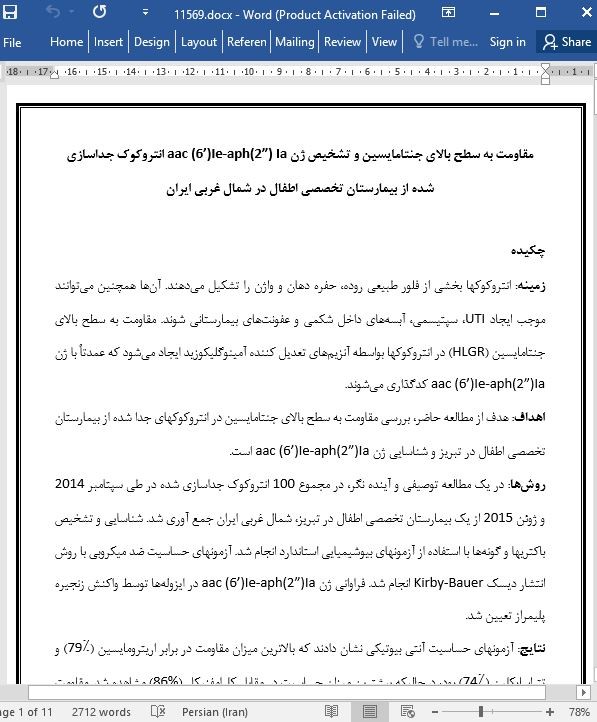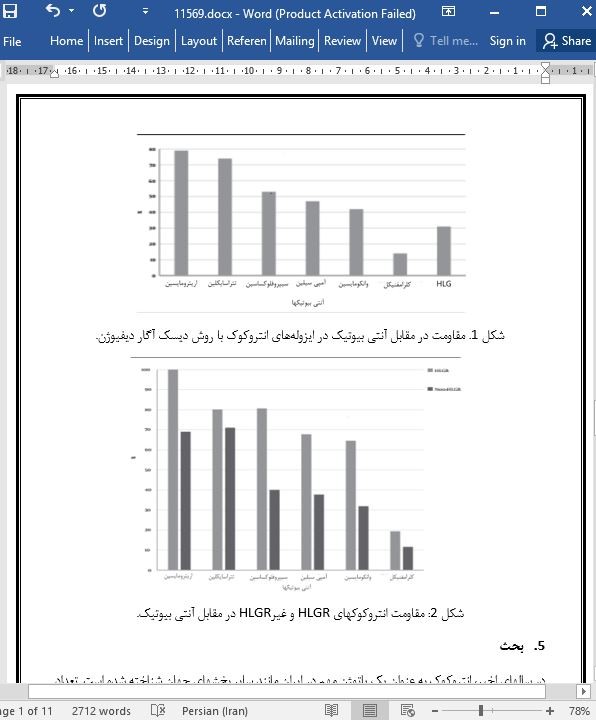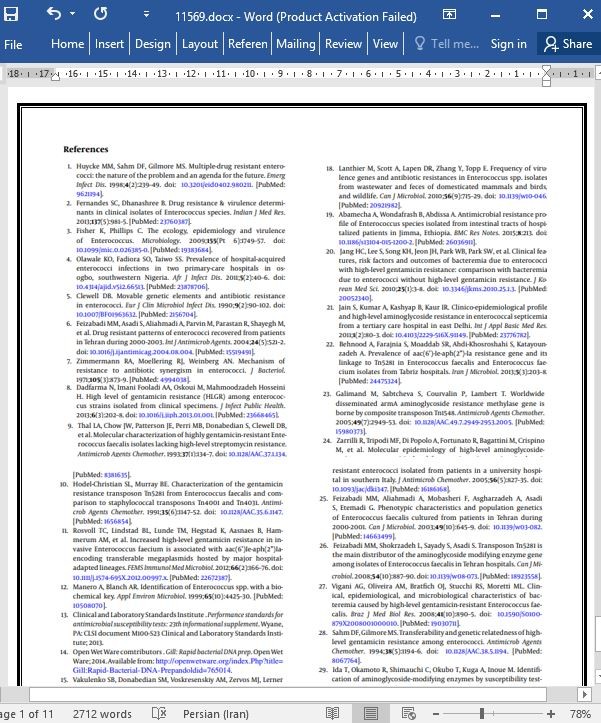
مقاومت به سطح بالای جنتامایسین و تشخیص ژن aac (6’)Ie-aph(2”) Ia انتروکوک جداسازی شده
چکیده
زمینه: انتروکوکها بخشی از فلور طبیعی روده، حفره دهان و واژن را تشکیل میدهند. آنها همچنین میتوانند موجب ایجاد UTI، سپتیسمی، آبسههای داخل شکمی و عفونتهای بیمارستانی شوند. مقاومت به سطح بالای جنتامایسین (HLGR) در انتروکوکها بواسطه آنزیمهای تعدیل کننده آمینوگلیکوزید ایجاد میشود که عمدتاً با ژن aac (6’)Ie-aph(2”)Ia کدگذاری میشوند.
اهداف: هدف از مطالعه حاضر، بررسی مقاومت به سطح بالای جنتامایسین در انتروکوکهای جدا شده از بیمارستان تخصصی اطفال در تبریز و شناسایی ژن aac (6’)Ie-aph(2”)Ia است.
روشها: در يک مطالعه توصيفی و آينده نگر، در مجموع 100 انتروکوک جداسازی شده در طي سپتامبر 2014 و ژوئن 2015 از يک بيمارستان تخصصی اطفال در تبریز، شمال غربی ايران جمع آوری شد. شناسایی و تشخیص باکتریها و گونهها با استفاده از آزمونهای بیوشیمیایی استاندارد انجام شد. آزمونهای حساسیت ضد میکروبی با روش انتشار دیسک Kirby-Bauer انجام شد. فراوانی ژن aac (6’)Ie-aph(2”)Ia در ایزولهها توسط واکنش زنجیره پلیمراز تعیین شد.
نتایج: آزمونهاي حساسيت آنتي بيوتيكي نشان دادند كه بالاترين میزان مقاومت در برابر اریترومايسين (79٪) و تتراسايكلين (74٪) بود، درحالیکه بیشترین میزان حساسیت در مقابل کلرامفنیکل (86%) مشاهده شد. مقاومت نسبت به آمپی سیلین، سیپروفلوکساسین و وانکومایسین به ترتیب در 47٪، 53٪ و 42٪ از ایزولهها تشخیص داده شد. در اين مطالعه 31 ایزوله (31٪) به عنوان HLGR شناسايي شدند كه 21 مورد از آنها (67.74٪) در ژنوم خود دارای ژن مقاومت aac (6’)-Ie-aph (2”)-Ia بودند. شیوع مقاومت نسبت به سایر آنتی بیوتیکها و مقاومت دارویی چندگانه (MDR) در بین ایزولههای HLGR نسبت به ایزولههای غیر HLGR بیشتر بود.
نتیجه گیری: ميزان بالای شيوع انتروكوكهای HLGR و MDR مسئله مهمي است كه با زمینههای پزشكي مرتبط است. نتایج این مطالعه نشان داد که ژن مقاومت aac (6’)-Ie-aph (2”)-Ia در بین ایزولههای مقاوم به جنتامایسین بسیار شایع است.
4.1. نتیجه گیری
نتایج ما شیوع بالای MDR و HLGRرا نشان داد که این امر بر ضرورت اقدامات کنترل و پیشگیری از مقاومت نسبت به انتروکوکها از طریق بررسی اپیدمی مقاومت و کاربرد روشهای تایپ ملکولی تاکید دارد. استفاده از دیسکهای حساسیت آنتی بیوتیکی به ویژه آمینوگلیکوزید، برای آزمایشات حساسیت آنتی بیوتیکی ضروری میباشد. مقاومت آنتی بیوتیکی و تایپ مولکولی آنها میتواند در شناخت ارگانیسمهای مهم پزشکی به ما کمک کند. علاوه بر این، استفاده از دیسکهای آنتی بیوتیکی آمینوگلیکوزید در آزمایش حساسیت میتواند در انتخاب یک درمان مناسب به ما کمک کند.
Abstract
Background: Enterococci form a part of the normal flora of the intestinal tract, the oral cavity, and the vagina; also, they can cause UTI, septicemia, intraabdominal abscesses, and nosocomial infections. High-level gentamicin resistance (HLGR) in enterococci is mediated by aminoglycoside modifying enzymes, which is mainly encoded by aac (6’)-Ie-aph (2”)-Ia gene.
Objectives: The present study aimed at investigating high-level gentamicin resistance in enterococci isolated from a pediatric hospital in Tabriz and detecting aac (6’) Ie-aph (2”) Ia gene.
Methods: In a descriptive and prospective study, a total of 100 enterococcal isolates were collected during September 2014 and June 2015 from a pediatric hospital in Tabriz, northwest of Iran. Bacterial identification and species determination were performed by standard biochemical tests. Antimicrobial susceptibility tests were performed by Kirby Bauer disc diffusion method. The frequency of aac (6’)-Ie-aph (2”)-Ia gene in the isolates was determined by polymerase chain reaction.
Results: Antibiotic susceptibility tests revealed that the highest resistance was against erythromycin (79%) and tetracycline (74%), whereas the highest susceptibility was observed against chloramphenicol (86%). Resistance to ampicillin, ciprofloxacin, and vancomycin were detected in 47%, 53%, and 42% of the isolates, respectively. In this study, 31 isolates (31%) were identified as HLGR from which 21 (67.74%) had resistance gene of aac (6’)-Ie-aph (2”)-Ia in their genome. The prevalence of resistance to other antibiotics and multi-drug resistance (MDR) was higher among the HLGR isolates compared to the non-HLGR isolates.
Conclusions: High prevalence rates of MDR and HLGR enterococci are important problems associated with medical settings. The results of this study indicated that aac (6’)-Ie-aph (2”)-Ia resistance gene is highly prevalent among gentamicin resistant isolates.
4.1. Conclusion
Our results revealed a high prevalence of MDR and HLGR, which underlines the necessity of control and prevention measures resistance in enterococci through epidemiological investigation of resistance and application of molecular typing methods. Using antibiotic sensitivity disks, particularly aminoglycoside, is essential in antibiotic sensitivity tests. Their antibiotic resistance and molecular typing could help us understand their medically important organisms; moreover, the use of aminoglycoside antibiotic disks in sensitivity testing could help us select an appropriate treatment.
چکیده
1. زمینه
2. اهداف
3. روشها
3.1. جمع آوری نمونه و شناسایی فنوتیپ
3.2. تعیین حساسیت آنتی بیوتیکی
3.3. استخراج DNA
3.4. واکنش زنجیره پلیمراز
3.5. تحلیل دادهها
4. نتایج
5. بحث
4.1. نتیجه گیری
Abstract
1. Background
2. Objectives
3. Methods
3.1. Sample Collection and Phenotypic Identification
3.2. Determination of Antibiotic Susceptibility
3.3. DNA Extraction
3.4. Polymerase Chain Reaction
3.5. Data Analysis
4. Results
5. Discussion
- اصل مقاله انگلیسی با فرمت ورد (word) با قابلیت ویرایش
- ترجمه فارسی مقاله با فرمت ورد (word) با قابلیت ویرایش، بدون آرم سایت ای ترجمه
- ترجمه فارسی مقاله با فرمت pdf، بدون آرم سایت ای ترجمه



